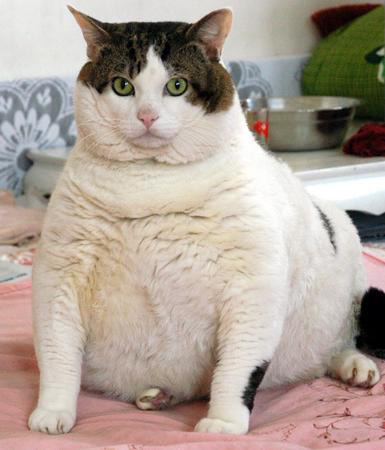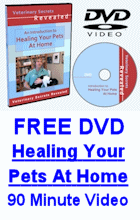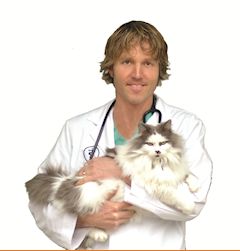|
Hi Friend,
--------------------------------
Is your dog or cat too fat?
--------------------------------

According to the Association for Pet Obesity Prevention, there are 81 million overweight dogs and cats in the U.S. right now – OVER 1/2 of the pet population is too fat.
BUT is this really a big deal- I mean HOW bad can it be?
Well, there are REAL and significant health risks, and I saw these daily in my Veterinary practice.
Here are the BIGGEST health problems related to weight:
————————————————–
Cancer- several types of cancer- from Lipomas to serious sarcomas
Arthritis
Ligament injury- especially Anterior Cruciate Ligaments
Liver Disease- especially in cats
Heart failure
High Blood pressure
Blindness
Kidney disease
Diabetes- in dogs and cats
—————————————
How to know if your pet is overweight
—————————————
In practice, I used the Body Condition Score – which rates dog and cat weight on a 1-5 scale.
1 – Ribs, spine and bony protrusions are easily seen at a distance. These pets have lost muscle mass and there is no observable body fat. Emaciated, bony, and starved in appearance.
2 – Ribs, spine and other bones are easily felt. These pets have an obvious waist when viewed from above and an abdominal tuck. Thin, lean or skinny in appearance.
3 – Ribs and spine are easily felt but not necessarily seen. There is a waist when viewed from above and the
abdomen is raised and not sagging when viewed from the side. Normal, ideal, and often muscular in appearance.
4 – Ribs and spine are hard to feel or count underneath fat deposits. Waist is distended or often pear-shaped when viewed from above. The abdomen sags when seen from the side. There are typically fat deposits on the hips, base of tail and chest. Overweight, heavy, husky or stout.
5 – Large fat deposits over the chest, back, tail base and hindquarters. The abdomen sags prominently and there is no waist when viewed from above. The chest and abdomen often appear distended or swollen. Obese.
—————————————–
50% in practice are OVERWEIGHT
—————————————–
Most pets that I saw were rated between 3-5- in other words over 1/2 of the dogs and cat that I saw in practice are OVERWEIGHT.
Now comes the BIG question.
——————————
What can YOU do about this?
——————————
I have MANY specific steps that you can take in my Inner Circle. And this months Video and Report will cover some of the Herbs that will help with weight loss in dogs and cats. You can get in on the $9.97 trial here:
http://www.theonlinevet.com
Here is some of what I reveal in my Inner Circle:
SOLUTIONS
DIET. This is the most important thing in creating weight loss. Your cat should be on a high-protein, low-carbohydrate, low-fat diet. There are specific high-protein feline diets available at your veterinarian or you can make your own.
Your dog’s diet should also change. I have had good luck with commercial weight-loss diets higher in fiber, but I have also seen good success with homemade diets higher in protein and fiber, lower in carbohydrates and fat.
EXERCISE. Most dogs that I see don’t get nearly enough exercise. Dogs are built to run all day, not spend their life waiting for us to get home from work. Commit to taking your dog out for at least 30 minutes twice daily; try to make it aerobic with a jog or on a bike. Consider a dog-walking service in your area.
For indoor cats, exercise is a challenge. I trained my cat to fetch a small crinkly ball. Some cats will race madly around when inspired by catnip.
TREATS. Stop any high-calorie treats, such as Pounce or Milk Bones. Try specific low-calorie treats, or even better switch to vegetables.
CONTROLLED FEEDING. Feed your pet controlled amounts twice daily; free-fed pets are often overweight.
CARNITINE. This has been shown to speed up weight loss in cats. The dose is 250 mg daily.
HOMEOPATHIC. Calcarea carbonica 30C can trigger weight loss. Give 3 tablets once daily for 4 weeks. It is worth trying when other strategies are not working.
Heal Your Pets At Home!
Best Wishes,
Dr Andrew Jones

P.S. This really is a silent killer that doesn’t get the respect it deserves. IF your dog or cat is overweight, then you are just ASKING for a health problem to pop up.
DO something about it now.
1. Exercise- commit to regular exercise with your pet.
2. Diet – ELIMINATE the high fat treats, and go to quality higher protein diet.
3. Get the newest Weight burning Herbs here:
http://www.theonlinevet.com

DISCLAIMER: This information is for educational purposes only and is not intended to replace the advice of your own veterinarian. Dr Andrew Jones resigned from the College of Veterinarians of B.C. effective December 1 2010, meaning he cannot answer specific questions about your pet's medical issues or make specific medical recommendations for your pet.
PRIVACY POLICY: We will never rent, sell, loan, provide, barter, exchange or in any way make available your personal information to others. You can unsubscribe or change your email address at any time using the links at the bottom of this email.
Copyright 2013 Four Paws Online Ltd.
Tel: 1-800-396-1534
Fax: 1-888-398-1378
www.theonlinevet.com
support@fourpawsonlineltd.com
|